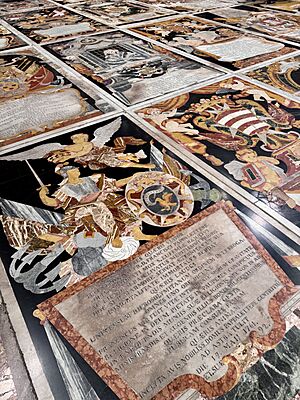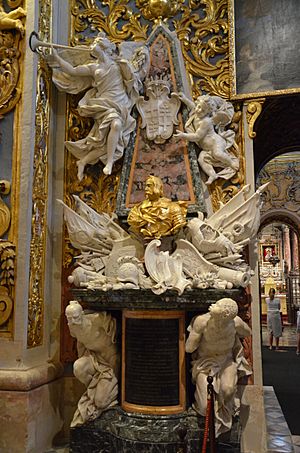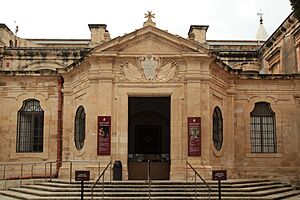Saint John's Co-Cathedral facts for kids
Quick facts for kids St John's Co-Cathedral |
|
|---|---|
|
Kon-Katidral ta' San Ġwann
|
|

Façade of St John's Co-Cathedral in 2020
|
|
| 35°53′52″N 14°30′46″E / 35.89778°N 14.51278°E | |
| Location | Valletta |
| Country | Malta |
| Denomination | Catholic Church |
| Website | www.stjohnscocathedral.com |
| History | |
| Former name(s) | Conventual Church of St. John The Major Conventual and Parochial Church of the Jerosolymitan Order dedicated to St John the Baptist |
| Status | Co-cathedral |
| Founder(s) | Jean de la Cassière |
| Dedication | John the Baptist |
| Consecrated | 20 February 1578 |
| Architecture | |
| Heritage designation | Grade 1 |
| Designated | 2008 |
| Architect(s) | Girolamo Cassar |
| Architectural type | Church |
| Style | Mannerist (exterior) Baroque (interior) |
| Groundbreaking | 1572 |
| Completed | 1577 |
| Specifications | |
| Length | 65 metres (213 ft) |
| Width | 40 metres (130 ft) |
| Nave width | 20 metres (66 ft) |
| Materials | Limestone |
| Administration | |
| Archdiocese | Archdiocese of Malta |
St John's Co-Cathedral (Maltese: Kon-Katidral ta' San Ġwann) is a beautiful Catholic church in Valletta, Malta. It is dedicated to John the Baptist. The church was built by the Order of St. John between 1573 and 1578. It was ordered by Grand Master Jean de la Cassière and was known as the Conventual Church of Saint John.
The famous Maltese architect Girolamo Cassar designed the church. He also designed many other important buildings in Valletta. Later, in the 1600s, the inside of the church was decorated in the amazing Baroque style. This work was done by Mattia Preti and other artists. Today, the church's interior is seen as one of the best examples of Baroque art in Europe.
Contents
History of the Co-Cathedral
After a big battle called the Great Siege of Malta in 1565, Grand Master Jean de la Cassière decided to build St. John's Co-Cathedral in 1572. It was first called Chiesa Conventuale di San Giovanni Battista in Italian. The architect Girolamo Cassar designed it. He was also in charge of building many other important places in Valletta.
Some people believe Cassar went to Rhodes to see an old church there. He might have used it as a model for St. John's. However, Cassar made his own changes and decisions, so he is known as the only architect of the co-cathedral. The church was finished in 1577. It became the main church for the Order of St. John, replacing an older church in Birgu.
In the 1660s, Grand Master Raphael Cotoner wanted the church's inside to be even more beautiful. He wanted it to be as grand as churches in Rome. An artist from Italy, Mattia Preti, was chosen to do this work. He completely changed the interior into the stunning Baroque style we see today.
St. John's was the Order's main church until the French took over Malta in 1798. Over time, this church became as important as the archbishop's main cathedral in Mdina. In the 1820s, the Bishop of Malta was allowed to use St John's as another main church. This is why it officially became a co-cathedral.
During World War II, in 1941, the outside of the cathedral was slightly damaged by bombs. Luckily, all the valuable artworks inside had been moved to safety before the bombing. So, no art was lost.
The cathedral was carefully restored between the late 1980s and early 1990s. In 2001, a special group was created to look after and protect the cathedral and its museum. The outside walls were restored from 2008 to 2010. A full restoration of the front of the building started in July 2014 and was finished in 2017.
Today, St. John's Co-Cathedral is one of the most popular places to visit in Malta. It is also listed as an important cultural building on the National Inventory of the Cultural Property of the Maltese Islands.
Outside the Co-Cathedral
The outside of the cathedral looks quite simple. It is built in a style called Mannerist, which was common for its architect, Girolamo Cassar. The front of the church is plain but well-balanced. It has two large bell towers on either side.
The main entrance has columns that support a balcony. From this balcony, the Grand Master used to speak to the people on special days. The outside of the church looks a bit like a fortress. This shows Cassar's background as a military engineer. It also reflects the serious mood of the Order after the Great Siege of Malta in 1565.
Inside the Co-Cathedral
The inside of St. John's Co-Cathedral is incredibly fancy and detailed. This is a big surprise compared to its simple outside. The interior was mostly decorated by Mattia Preti, an artist and knight from Italy, during the Baroque period. Preti designed the detailed carvings on the stone walls. He also painted the arched ceiling and the altars on the sides with scenes from the life of John the Baptist.
The figures painted on the ceiling next to each column look like real 3D statues at first. But if you look closely, you can see that the artist used clever shadows and placement to create this amazing illusion. All the carvings were done directly on the walls, not made separately and then attached. The Maltese limestone used to build the cathedral is perfect for such detailed carving.
The entire marble floor is made up of about 400 tombs. These are where many Knights and officers of the Order were buried. There is also a special underground room called a crypt. It holds the tombs of important Grand Masters, including Jean Parisot de Valette and Alof de Wignacourt.
In 1703, a sculptor named Giuseppe Mazzuoli finished a marble sculpture group called The Baptism of Christ. This artwork is found at the main altar.
Chapels of the Order
The cathedral has nine chapels. One is for Our Lady of Philermos. The other eight are for the patron saints of each of the Order's langues, which were like different divisions or groups of knights.
On the south side of the church, you will find:
- Chapel of Our Lady of Philermos: This chapel was once home to a special icon of Our Lady of Philermos.
- Chapel of the Langue of Auvergne: Dedicated to Saint Sebastian. Its altarpiece shows the saint's martyrdom.
- Chapel of the Langue of Aragon: Dedicated to Saint George. Its altarpiece, Saint George on Horseback, is a famous work by Mattia Preti. Several Grand Masters are buried here.
- Chapel of the Langue of Castile, Leon and Portugal: Dedicated to Saint James. Its altarpiece, also by Mattia Preti, shows the saint beautifully. Grand Masters António Manoel de Vilhena and Manuel Pinto da Fonseca are buried in grand marble tombs here.
On the north side of the church, you will find:
- Chapel of the Anglo-Bavarian Langue: Dedicated to Saint Charles Borromeo. It once held many holy relics.
- Chapel of the Langue of Provence: Dedicated to Saint Michael the Archangel. Its altarpiece shows the archangel fighting against Satan.
- Chapel of the Langue of France: Dedicated to the Conversion of Saint Paul. Its altarpiece, The Conversion of St Paul on the Way to Damascus, is by Mattia Preti.
- Chapel of the Langue of Italy: Dedicated to the Immaculate Conception and Saint Catherine of Alexandria. Its altarpiece, The Mystic Marriage of St Catherine, is by Mattia Preti.
- Chapel of the Langue of Germany: Dedicated to the Epiphany of Christ. The altarpiece, The Adoration of the Magi, is by the Maltese painter Stefano Erardi.
Famous Artworks
The most famous artwork in the church is the painting The Beheading of Saint John the Baptist (1608) by Caravaggio. This painting is considered one of Caravaggio's best works. It is the largest painting he ever made and the only one he signed. You can see it in the Oratory, a special room where it was originally painted to be displayed.
This painting shows Caravaggio's amazing use of chiaroscuro, a style where he uses strong contrasts between light and dark. A circle of light highlights the scene where St John is beheaded. The Oratory also has another Caravaggio painting, Saint Jerome Writing (1607–1608).
Another impressive part of the church is the collection of marble tombstones on the floor of the nave. Important knights were buried here, with the most important ones closer to the front of the church. These tombstones are richly decorated with colorful marble and the coats of arms of the knights buried beneath them. They often show images that tell stories of the knight's victories in battle, creating a beautiful display.
Next to the church is the St John's Co-Cathedral Museum. It holds many art objects, including beautiful Flemish Tapestries designed by Peter Paul Rubens. These tapestries were given to the church by Grand Master Ramon Perellos y Roccaful. The museum also has paintings of Grand Masters and other artworks that used to be in the side chapels.
Visiting the Co-Cathedral
St. John's Co-Cathedral is in the center of Valletta. It's a short walk from the main bus station near City Gate. The main entrance is in St John's Square. However, visitors usually enter from Great Siege Square on Republic Street, across from the Law Courts building.
There is a fee for visitors to enter the cathedral. But if you are only visiting for Mass (a church service), you do not need to pay the entrance fee.
See also
 In Spanish: Concatedral de San Juan (La Valeta) para niños
In Spanish: Concatedral de San Juan (La Valeta) para niños
- Culture of Malta
- History of Malta
- List of churches in Malta
- Religion in Malta










